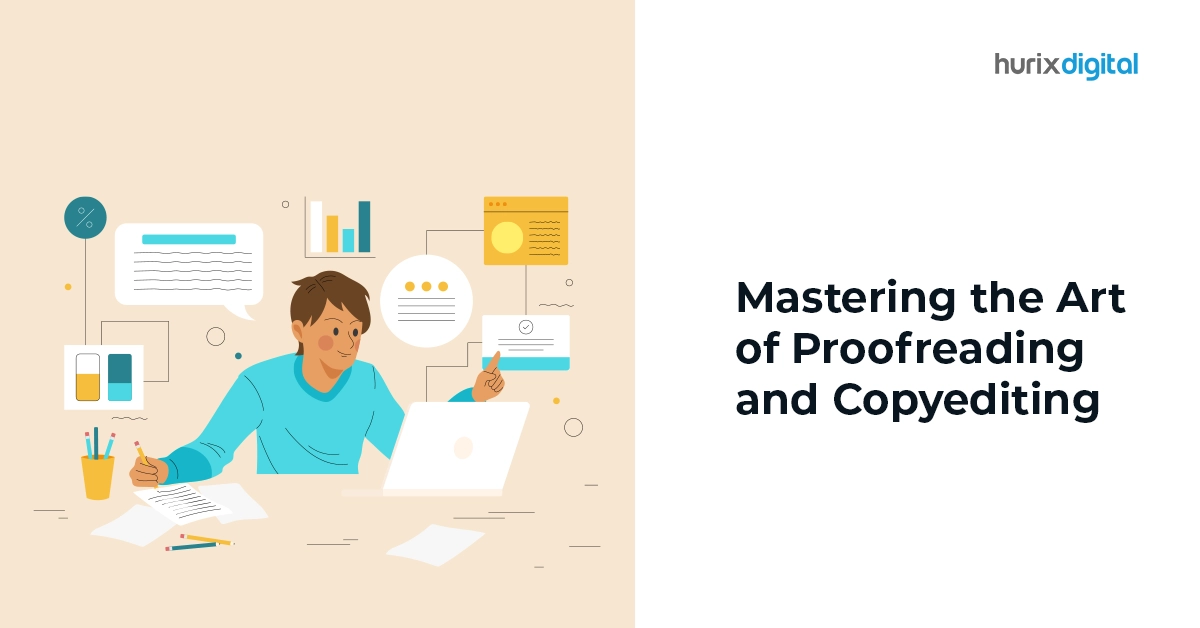
Mastering the Art of Proofreading and Copyediting
Summary
Explore essential techniques for effective proofreading and copyediting. This blog offers tips to refine your editing skills and ensure error-free content.
Copyediting and proofreading are important steps when getting your writing ready to be published. They have specific jobs, and depending on what you’re writing, they can make a big difference.
Copyediting focuses on improving the overall quality, clarity, and consistency of the writing. It checks for things like grammar, spelling, and sentence structure. Proofreading, on the other hand, is the final check for errors before publishing. It looks for typos, punctuation mistakes, and any remaining issues.
Both copyediting and proofreading services come in handy to ensure your writing reaches its highest potential. As an author, understanding the distinction between copyediting and proofreading is crucial. It not only helps refine your writing but also ensures a polished final product.
In this blog, we will explore some effective editing techniques and share essential proofreading tips. We’ll also discuss must-have fact-checking skills to assist you in the process.
Table of Contents:
- What is Copyediting?
- Essential Editing Techniques: A Must-Know Guide for Copy Editors
- What is Proofreading?
- 3 Important Proofreading Tips to Explore
- 5 Fact-Checking Skills Every Editor Must Have
- Conclusion
What is Copyediting?
In the publishing world, copyediting stands as a critical checkpoint. A well-polished manuscript always elevates the content and, in turn, the reader’s experience. Copyediting is the first stage of revision before publishing. It occurs once the author has completed their writing and is satisfied with the work.
A copyeditor comes in with a fresh pair of eyes, focusing on the consistency of the writing. The purpose of a copyeditor should be to improve the quality of writing in terms of style, vocabulary, readability, and natural phrasing, or “flow.”
Also Read: Eight Pro Tips For Proofreading in 2024!
Essential Editing Techniques: A Must-Know Guide for Copy Editors
Listed below is a fundamental checklist of essential editing techniques for copy editors:
1. Attention to Detail
Pay very close attention to surface-level errors. Ensure that the capitalization is consistent.
Check for the hyphenation and spelling. See if there is any incorrect formatting of citations and references. Also, eliminate repetition and redundancy in any words or sentences in the manuscript.
2. Tone and Structure of the Content
Examine if the structure of sentences is appropriate. Check if the author has chosen the best words to express the ideas.
Also, ensure that the transitions are all in order and smooth. It should not feel forceful. Also, see if the tone is appropriate for the audience based on the material of the content.
3. Overall Coherence
Ensure that overall coherence is maintained throughout the draft. Make sure the flow of the chapters is logical. Check if all the questions raised throughout the chapters are answered eventually.
Also, confirm that each paragraph supports the main idea of your writing. This way, your work will be clear and easy to follow, and every part will contribute to your overall message.
4. Respect the Author’s Voice
Copyediting is often a behind-the-scenes, unsung task. While writers are ultimately the decision-makers, it is crucial to acknowledge and emphasize their insights and resolutions.
Avoid altering the tone of their work, whether you concur or disagree with it. It’s essential to recognize that the primary objective of a copy editor is to elevate the clarity and coherence of the writing without diminishing the distinctive voice of the author.
In essence, the copyeditor’s aim should be to refine the writing’s clarity and cohesion, preserving and enhancing the unique voice of the author rather than eroding it away.
What is Proofreading?
Proofreading is generally the final step of the revision process before it is sent out to be published. It is done after copy editing has been completed. In this process, a proofreader carefully examines the written manuscript to check and correct errors in grammar, punctuation, spelling, formatting, etc.
Proofreading includes identifying and correcting the following:
- Grammar mistakes and mechanical issues
- Spelling errors and typos
- Incorrect punctuation
- Formatting and writing inconsistencies
- Check for Proper names, Citations, Punctuation, Page numbers, Header/footer material, fonts, etc.
3 Important Proofreading Tips to Explore
Here are the top three important proofreading tips to enhance the quality of your written work:
1. Read Out Loud
Reading your work aloud is an effective way to identify errors and awkward phrasing. Hearing the words can highlight issues that may be overlooked when reading silently.
Additionally, try changing the medium through which you review your work. If you’ve been working on a computer, print out a hard copy or view your document on a different device. Changing the medium can offer a new perspective, making it easier to spot errors.
2. Take a Break Before Proofreading
After completing your writing, take a break before diving into proofreading. This break allows you to approach your work with fresh eyes, making it easier to spot errors and inconsistencies.
Ideally, take a break for at least a few hours or even a day if time permits. This distance helps you detach from the content and approach it more objectively during proofreading.
3. Use Relevant Tools
While your own eyes are crucial, don’t rely solely on them. Utilize spelling and grammar checkers, as well as proofreading tools like Grammarly or Hemingway Editor, to catch errors you might miss. However, remember that these tools are not infallible, so always double-check any suggestions they make.
5 Fact-Checking Skills Every Editor Must Have
If you want to learn fact-checking, the skills mentioned below are going to come in handy for you:
1. Critical Thinking
Be skeptical and verify everything before you pass it on. Question, analyze, and evaluate the information you find. You should not accept anything at face value but instead look for evidence, logic, and context.
2. Research Skills
Find, access, and use credible sources of information to research. Research helps you collect and compare the information you need to verify or refute a claim.
3. Data Literacy
You should know how to read and analyze charts, graphs, tables, & other visuals of data. It helps you understand the numbers, trends, and patterns in the data you are checking.
4. Upholding Ethical Standards
Stay true to the principles and values of your job. You should respect the rights, privacy, and dignity of the sources, subjects, and audiences of the information you are checking. You should also know how to report your findings in an unbiased, accurate, and transparent way.
5. Collaboration Skills
You should know how to communicate, cooperate, and coordinate with your editors, stakeholders, and colleagues. Collaboration helps you improve your efficiency and quality.
Also Read: Why Professional Proofreading Services are Essential for Businesses
Conclusion
Professional copyediting and proofreading services play a crucial role in refining your written content, ensuring it is polished, error-free, and powerfully conveys your message to your target audience.
Today, there are many AI-powered editing and proofreading software programs available that deliver precision in no time. Investing in such services will help you stand out in a competitive market, establish credibility, and make a lasting impression on your readers.
Hurix Digital provides an unparalleled solution for copyediting services. We ensure your content enhances the credibility and professionalism of your brand, instilling confidence in your customers and stakeholders.
Contact us and get your quotation for free!

Vice President – Digital Content Transformation. He is PMP, CSM, and CPACC certified and has 20+ years of experience in Project Management, Delivery Management, and managing the Offshore Development Centre (ODC).



